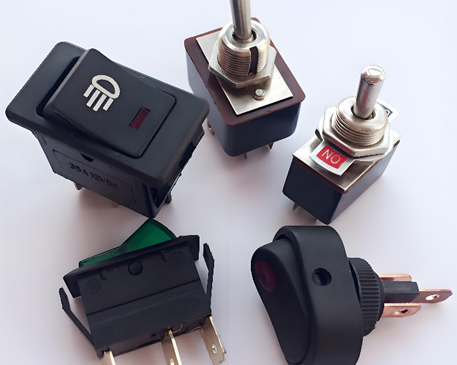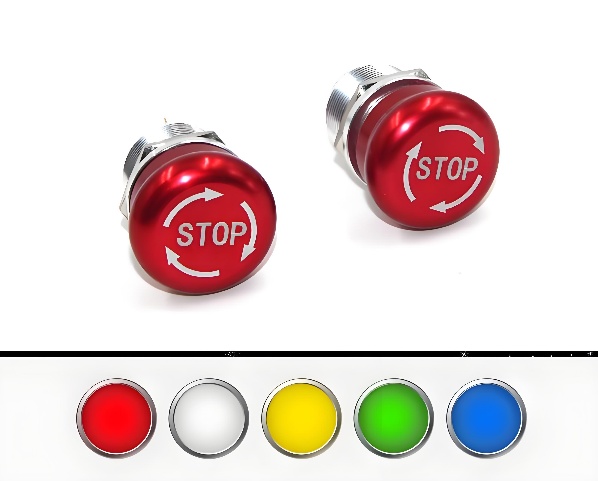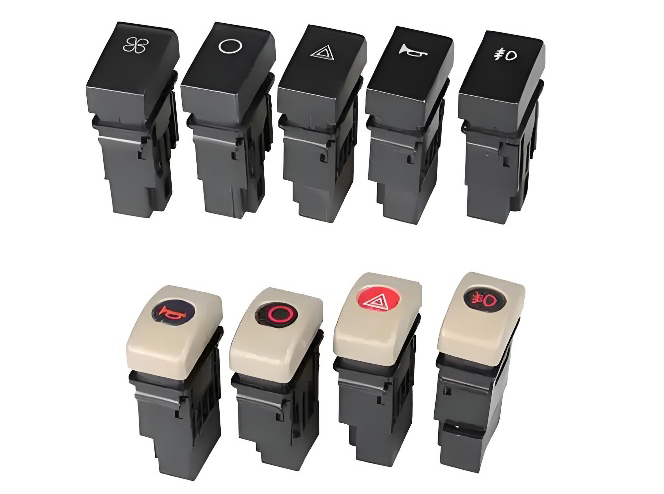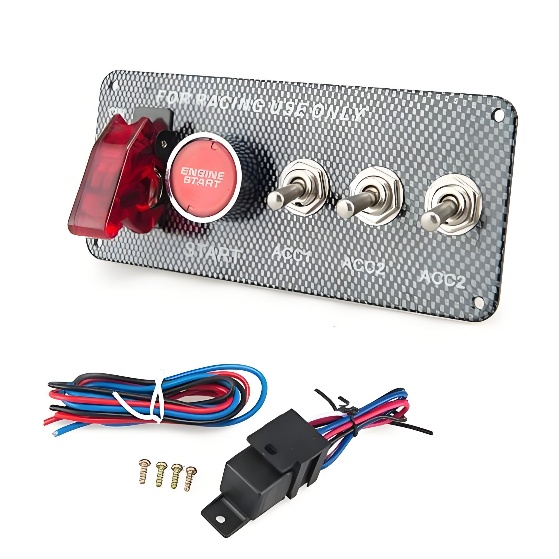
When it comes to a car’s functionality and overall safety, it’s easy to focus on the engine, tires, or brakes. But have you ever thought about the importance of the switches in your car? Car switches are integral components that control various functions such as lights, windshield wipers, air conditioning, and more. Without these seemingly small switches working correctly, the car would be difficult and even dangerous to operate.
A damaged car switch, though it may appear as a minor inconvenience at first, can lead to a series of problems that affect your safety, driving experience, and overall vehicle performance. In this blog, we’ll go through the seven common signs of damage to a car’s switch, the importance of these switches, how to repair them, and what to do if you suspect a problem.
7 Signs Indicating Damage to the Car’s Switch

Unresponsive Switches
One of the most obvious signs of damage is when a switch stops working or becomes unresponsive. If you notice that certain features like the headlights, windshield wipers, or turn signals aren’t activating when you press the respective switch, then you’re likely dealing with a damaged switch. An unresponsive switch could indicate that the internal mechanism is broken or that the electrical connection is faulty.
Delayed Response Time
A functioning switch should work immediately when pressed. If you press a switch and notice a delay before the action takes place—whether it’s turning on the lights, activating the wipers, or engaging the horn—it’s a clear sign that the switch is malfunctioning. This delay is usually caused by worn-out internal contacts or loose wiring, which can deteriorate over time.
Erratic Behavior
Another common sign of damage is erratic behavior from the switch. For instance, you may find that the headlights flicker or the windshield wipers work intermittently, even if the switch is in the “on” position. This is typically due to the electrical connections within the switch being damaged, causing it to send inconsistent signals to the relevant system.
Physical Damage
Sometimes, the damage to a car switch isn’t subtle and can be seen with the naked eye. Cracks, broken components, or worn-out buttons are all visible signs that a switch may be failing. If you notice any obvious physical damage to the switch, such as a button that is loose or stuck, it’s essential to address the issue immediately to avoid further complications.
Burning Smell or Overheating
If a switch is damaged or malfunctioning, it can sometimes cause the internal components to overheat. Overheating can lead to a burning smell, which is an immediate warning sign of electrical problems. If you smell something burning or notice that a switch becomes excessively hot to the touch, it’s crucial to turn off the vehicle and inspect the switch to avoid the risk of fire or additional damage.
Switches Sticking or Jamming
Switches that stick or jam when pressed are a clear indication of mechanical failure. This could be caused by dirt, grime, or wear and tear on the internal components of the switch. If you notice that a switch is physically difficult to press or that it doesn’t spring back into place after being pressed, it could be time for a replacement.
Flickering or Inconsistent Lights
Flickering dashboard lights, headlights, or interior lighting can also be linked to a malfunctioning switch. These lights may flicker on and off randomly, or fail to turn on when they should. The cause of this issue could be a problem with the switch that controls the lighting system, where the internal electrical connection is loose or damaged.
The Importance of a Car’s Switch

Car switches may seem like small, insignificant components of a vehicle, but they are essential for the proper functioning and safety of your car. These switches are responsible for controlling various systems within your vehicle, from the basic functions like turning on the lights to more advanced ones like adjusting the air conditioning or controlling the cruise control.
Here are a few key reasons why car switches are so important:
Driver Control: Many of the switches in your vehicle are responsible for providing you with direct control over your driving experience. From adjusting the climate controls to activating safety features such as hazard lights, your switches allow you to fine-tune and personalise your ride.
Safety Features: Some switches control critical safety features such as your vehicle’s airbags, traction control, or lights. If these switches fail, it can lead to serious safety concerns, both for you and others on the road.
Convenience: Modern vehicles come equipped with numerous comfort and convenience features that are operated through switches. Functions like seat warmers, wipers, and even advanced entertainment systems are all controlled by switches that make your driving experience more enjoyable.
Electrical Systems: Many car switches are an integral part of the vehicle’s electrical systems. Damaged switches can cause short circuits, voltage fluctuations, or failure of crucial electrical components in your car. Maintaining these switches ensures that the entire electrical system runs smoothly.
Preventing Bigger Issues: A malfunctioning switch can lead to more significant problems in the car’s wiring or related components. For instance, a failed switch might short-circuit the entire lighting system, causing electrical damage that is more costly to fix than simply replacing the switch.
How to Repair a Car’s Switch?

If you’ve noticed any of the signs mentioned above, it’s crucial to address the issue before it gets worse. Depending on the type and extent of damage, repairing a car switch can be a DIY job or may require professional help.
Here’s how to go about it:
1. Diagnose the Problem
Before you start repairing a damaged switch, it’s important to pinpoint the exact problem. Check whether the issue is with the switch itself or if it might be caused by other factors, such as the fuse, wiring, or electrical connections. If the switch is physically damaged or unresponsive, it’s likely time for a replacement.
2. Gather Necessary Tools
If you decide to repair the switch yourself, you’ll need some basic tools. This might include a flathead screwdriver, socket wrench set, electrical contact cleaner, and possibly a replacement switch if the old one is beyond repair.
3. Remove the Faulty Switch
For most switches, you’ll need to remove the trim or panel that surrounds the switch. This is usually done with a flathead screwdriver or a plastic pry tool to avoid damaging the surrounding materials. Once you have access, disconnect the wiring harness from the switch.
4. Inspect and Clean the Switch
Sometimes, a malfunctioning switch may just need a cleaning. Dust, dirt, or corrosion can accumulate inside the switch and prevent it from functioning correctly. Use electrical contact cleaner to clean the switch’s components, ensuring that everything is free of debris.
5. Replace the Switch
If cleaning doesn’t solve the issue or if the switch is physically broken, you’ll need to replace it. Purchase a replacement switch that matches your vehicle’s specifications, and carefully install the new switch. Be sure to reconnect the wiring harness correctly.
6. Test the New Switch
After replacing the switch, test it to ensure that it works correctly. Make sure that it responds immediately, without delay, and that it activates the corresponding system as intended. If everything is functioning properly, reassemble the trim or panel around the switch.
7. Seek Professional Help
If the problem persists or if you’re unsure about performing the repair yourself, it’s best to take your vehicle to a professional mechanic. They can diagnose the issue more accurately and replace the switch or related components as needed.
Conclusion
Automotive switches are often overlooked, yet they play a vital role in ensuring a smooth and safe vehicle operation. Malfunctioning switches can cause a range of problems, from minor inconveniences to serious safety hazards. By recognising signs of damage early and understanding the importance of these components, you can take proactive steps to keep your vehicle in top condition.
If you notice any of these signs, such as unresponsiveness, sluggish response, or unusual behaviour, it’s crucial to address the issue as soon as possible. Whether you choose to repair the switch yourself or seek professional assistance, taking action can prevent further complications and ensure safe driving!




